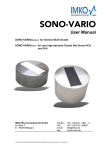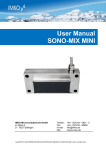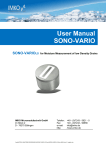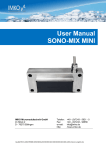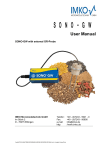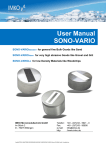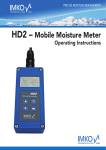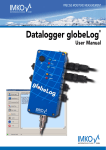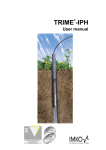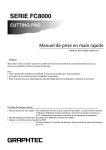Download SONO-MOVE - MESA Systems Co.
Transcript
SONO-MOVE User Manual SONO-MOVECarbide in Carbide Design SONO-MOVEPTFE in PTFE Design IMKO Micromodultechnik GmbH Im Stöck 2 D - 76275 Ettlingen Telefon: Fax: e-mail: http: I:\publik\TECH_MAN\TRIME-SONO\ENGLISH\SONO-MOVE\SONO-MOVE-MAN-Vers1_4-english.doc +49 - (0)7243 - 5921 - 0 +49 - (0)7243 - 90856 [email protected] //www.imko.de 2/30 User Manual for SONO-MOVE As of 14. April 2010 Thank you for buying an IMKO moisture probe. Please carefully read these instructions in order to achieve ideal results with your probe SONO-MOVE for the in-line moisture measurement. Should you have any questions or suggestions regarding your new probe after reading, please do not hesitate to contact our authorised dealers or IMKO directly. We will gladly help you. List of Content: 1. Instrument Description SONO-MOVE ....................................................................................4 The patented TRIME TDR-Measuring Method .............................................................4 1.1.2. TRIME compared to other Measuring Methods ............................................................4 1.1.3. Areas of Application ........................................................................................................4 1.2. ® Mode of Operation..................................................................................................................5 1.2.1. Measurement Value Collection with continual Average Value and Filtering ..................5 1.2.2. Determination of the mineral Concentration ...................................................................5 1.2.3. Temperature Measurement ............................................................................................5 1.2.4. Analogue Outputs ...........................................................................................................5 1.2.5. The serial RS485 interface .............................................................................................6 1.2.6. Error Reports and Error Messages .................................................................................6 1.3. Configuration of the Measure Mode.......................................................................................7 1.4. Operation Mode CF at non-continuous Material Flow ...........................................................7 1.4.1. 1.5. Average Time in the measurement mode CF .................................................................8 Calibration Curves..................................................................................................................9 1.5.1. 2. ® 1.1.1. SONO-MOVE for measuring Moisture of Sand and Aggregates..................................12 1.6. Creating a linear Calibration Curve for a specific Material...................................................13 1.7. Connection Plug ...................................................................................................................15 1.8. Connection of RS485 to the USB Module............................................................................16 Quick guide for the Software SONO-CONFIG .....................................................................17 2.1.1. Scan of connected SONO probes on the RS485 interface...........................................17 2.1.2. Configuration of Measure Mode....................................................................................18 2.1.3. Analogue outputs of the SONO probe ..........................................................................18 2.1.4. Selection of the individual Calibration Curves ..............................................................19 2.1.5. Test run in the respective Measurement Mode ............................................................20 2.1.6. 3. 4. 3/30 Basic Balancing in Air and Water..................................................................................21 Installation of the Probe ........................................................................................................22 3.1. Assembly Instructions ..........................................................................................................22 3.2. SONO-MOVECarbide Assembly Dimensions......................................................................23 3.3. Mounting SONO-MOVECarbide across a Conveyor Belt ....................................................24 3.4. SONO-MOVECarbide LH with low Installation Height .........................................................25 3.5. Mounting SONO-MOVECarbide LH with low Installation Height .........................................26 3.6. SONO-MOVEPTFE Assembly Dimension ...........................................................................27 3.7. Mounting SONO-MOVEPTFE across a Conveyor Belt .......................................................28 Technical Data SONO-MOVE ................................................................................................29 4/30 1. Instrument Description SONO-MOVE ® 1.1.1. The patented TRIME TDR-Measuring Method The TDR technology (Time-Domain-Reflectometry) is a radar-based dielectric measuring procedure at which the transit times of electromagnetic pulses for the measurement of dielectric constants, respectively the moisture content are determined. SONO-MOVECarbid consists of a high grade carbid casing with a wear-resistant sensor head with ceramic window. The SONO-MOVEPTFE probe head is made of PTFE and thus providing best possible anti adhesive properties. An integrated TRIME TDR measuring transducer is installed into the casing. A high frequency TDR pulse (1GHz), passes along wave guides and generates an electro-magnetic field around these guides and herewith also in the material surrounding the probe. Using a new patented measuring method, IMKO has achieved to measure the transit time of this pulse with a resolution of 3 picoseconds, consequently determine the moisture and the conductivity of the measured material. The established moisture content, as well as the conductivity, respectively the temperature, can either be uploaded directly into a SPC via two analogue outputs 0(4) ...20 mA or recalled via a serial RS485 interface. ® 1.1.2. TRIME compared to other Measuring Methods ® In contrary to conventional capacitive or microwave measuring methods, the TRIME technology (Time-Domain-Reflectometry with Intelligent Micromodule Elements) does not only enable the measuring of the moisture but also to verify if the mineral concentration specified in a recipe has been complied with. This means more reliability at the production. TRIME-TDR technology operates in the ideal frequency range between 600MHz and 1,2 GHz. Capacitive measuring methods (also referred to as Frequency-Domain-Technology) , depending on the device, operate within a frequency range between 5MHz and 40MHz and are therefore prone to interference due to disturbance such as the temperature and the mineral contents of the measured material. Microwave measuring systems operate with high frequencies >2GHz. At these frequencies, nonlinearities are generated which require very complex compensation. For this reason, microwave measuring methods are more sensitive in regard to temperature variation. SONO probes calibrate themselves in the event of abrasion due to a novel and innovative probe design. This consequently means longer maintenance intervals and, at the same time, more precise measurement values. The modular TRIME technology enables a manifold of special applications without much effort due to the fact that it can be variably adjusted to many applications. 1.1.3. Areas of Application The SONO-MOVE probe is suited for installation over a conveyor belt. • The SONO-MOVECarbide is suited for measuring of highly abrasive materials. The novel probe head consists of highly abrasion-resistant carbide with a rectangular ceramic window. The material on the conveyor belt is affected only slightly with the wedge-shaped structure at only 12mm thickness of the probe. The SONO-MOVECarbide LH has a lower installation height. • The SONO-MOVEPTFE is suited for measuring of highly adhesive materials such as lime sand. The probe head is made of PTFE and thus providing best possible anti adhesive properties. 5/30 1.2. Mode of Operation 1.2.1. Measurement Value Collection with continual Average Value and Filtering The probe SONO-MOVE internally measures at a rate of 100 measurements per seconds and issues the measurement value at a cycle time of up to 200 milliseconds (depending on the measurement mode) at the analogue output. In the Measurement Mode CS (Cyclic-Successive), an average value is not accumulated and the cycle time here is also 200 milliseconds. In the Measurement Mode CF (Cyclic-Float-Average), not the momentarily measured individual values are directly issued, but the floating average value is accumulated via a variable number of measurements (Floating Average) in order to filter out temporary variations. These variations can be caused by inhomogeneous moisture distribution in the material surrounding the sensor head. The delivery scope of SONO-MOVE includes suited parameters for the averaging period and a universally applicable filter function deployable for currently usual applications. The time for the average value accumulation, as well as various filter functions, can be adjusted for special applications. 1.2.2. Determination of the mineral Concentration With the radar-based TRIME measurement method, it is now possible for the first time, not only to measure the moisture, but also to provide information regarding the conductivity, respectively the mineral concentration or the composition of a special material. Hereby, the attenuation of the radar pulse in the measured volume fraction of the material is determined. This novel and innovative measurement delivers a radar-based conductance value (RbC – Radar-based-Conductivity) in dS/m as characteristic value which is determined in dependency of the mineral concentration and is issued as an unscaled value. The RbC-measurement range of the SONO-MOVE is 0..12dS/m 1.2.3. Temperature Measurement A temperature sensor is installed into the SONO-MOVE which establishes the casing temperature beneath the electronic housing (see point 2.2). The temperature can optionally be issued at the analogue output 2. As the TRIME electronics operates with a power of approximately 1.5 W, the probe casing does slightly heat up. A very precise measurement of the material temperature is therefore only possible to a certain degree and only when the electronic housing is completely is completely surrounded by the material. The material temperature can be determined after an external calibration and compensation of the sensor self-heating. 1.2.4. Analogue Outputs The measurement values are issued as a current signal via the analogue output. With the help of the service program SONO-CONFIG, the SONO-MOVE can be set to the two versions for 0..20mA or 4..20mA. Furthermore, it is also possible to variably adjust the moisture dynamic range e.g. to 0-10%, 0-20% or 0-30%. For a 0-10V DC voltage output, a 500R resistor can be installed in order to reach a 0..10V output. Analogue Output 1: Moisture in % (0…20%, variable adjustable) Analogue Output 2: Conductivity (RbC) or optionally the temperature. In addition, there is also the option to split the analogue output 2 into two ranges: into 4..11mA for the temperature and 12..20mA for the conductivity. The analogue output 2 hereby changes over into an adjustable one-second cycle between these two (current) measurement windows. 6/30 For the analogue outputs 1 and 2 there are thus two adjustable options: Analog Output: (two possible selections) 0..20mA 4..20mA Output Channel 1 and 2: (three possible selections) 1. Moist, Temp. Analogue output 1 for moisture, output 2 for temperature. or 2. Moist, Conductivity Analogue output 1 for moisture, output 2 for conductivity in a range of 0..20dS/m. or 3. Moist, Temp/Conductivity Analogue output 1 for moisture, output 2 for both, temperature and conductivity with an automatic current-window change. For analogue output 1 and 2 the moisture dynamic range and temperature dynamic range can be variably adjusted: Moisture Range: Maximum: e.g. 20 (Set in %) Minimum: 0 Temp. Range: Maximum: 100 °C Minimum: 0 °C 1.2.5. The serial RS485 interface SONO-MOVE is equipped with a standard RS485 interface to serially readout individual parameters or measurement values. An easy to implement data transfer protocol enables the connection of several sensors/probes at the RS485-Interface. In addition, the SONO-MOVE can be directly connected to the USB port of a PC, in order to adjust individual measuring parameters or conduct calibrations, via the RS485 USB Module which can be provided by IMKO. 1.2.6. Error Reports and Error Messages SONO-MOVE is very fault-tolerant. This enables failure-free operation. Error messages can be recalled via the serial RS485 interface. 7/30 1.3. Configuration of the Measure Mode The configuration of SONO-MOVE is preset in the factory before delivery. A process-related later optimisation of this device-internal setting is possible with the help of the service program SONOCONFIG. For all activities regarding parameter setting and calibration the probe can be directly connected via the RS485 interface to the PC via a RS485 USB-Module which is available from IMKO. The following settings of SONO-MOVE can be amended with the service program SONO-CONFIG: Measurement-Mode and Parameters: • Measurement Mode A-On-Request (only in network operation for the retrieval of measurement values via the RS485 interface). • Measurement Mode C Cyclic: Setting CF: (Cyclic-Float-Average) With continual floating average value with filtering and an accuracy of up to 0.1% Setting CS: (Cyclic-Successive) Without floating average for fast measurement procedures with internal up to 100 measurements per second and a cycle time of 200 milliseconds at the analogue output. • Average Time (reaction rate of the measurement values) • Calibration (if completely different materials are deployed) • Filter Function Each of these settings will be preserved after shut down of the probe and is therefore stored on a permanent basis. 1.4. Operation Mode CF at non-continuous Material Flow SONO-MOVE is supplied ex factory with suited parameters for the averaging time and with a universally deployable filter function suited for most currently applications. The setting options and special functions of the SONO-MOVE depicted in this chapter are only rarely required. It is necessary to take into consideration that the modification of the settings or the realisation of these special functions may lead to faulty operation of the probe! For applications with non-continuous material flow, there is the option to optimise the control of the measurement process via the adjustable filter values Filter-Lower-Limit, Filter-Upper-Limit and the time constant No-Material-Keep-Time. The continual/floating averaging can be set with the parameter Average-Time. Detection of malfunctions at the probe head SONO-MOVE is able to identify, if temporarily no or less material is at the probe head and can filter out such inaccurate measurement values (Filter-Lower-Limit). Particular attention should be directed at those time periods in which the measurement area of the probe is only partially filled with material for a longer time, i.e. the material (sand) temporarily no longer completely covers the probe head. During these periods (Lower-Limit-Keep-Time), the probe would establish a value that is too low. The Lower-Limit-Keep-Time sets the maximum possible time where the probe could determine inaccurate (too low) measurement values. Furthermore, the passing or wiping of the probe head with metal blades or wipers can lead to the establishment of too high measurement values (Filter-Upper-Limit). The Upper-Limit-Keep-Time sets the maximum possible time where the probe would determine inaccurate (too high) measurement values. 8/30 Using a complex algorithm, SONO-MOVE is able to filter out such faulty individual measurement values. The standard settings in the Measurement Mode CF for the filter functions depicted in the following have proven themselves to be useful for many applications and should only be altered for special applications. Filter Parameter in the Measurement Mode CF Function Average-Time (Continual/Floating Average Value) Standard Setting: 3 Setting Range: 2…20 The time (in seconds) for the generation of the continual/floating average value can be set with this parameter. Filter-Upper-Limit Standard Setting: 1,5 Setting Range: 1,1….1,5 Too high measurement values generated due to metal wipers or blades are filtered out. Upper-Limit-Keep-Time Standard Setting: 4 Setting Range: 2...10 The maximum duration (in seconds) of the filter function for Upper-Limit-failures (too high measurement values) can be set with this parameter. Filter-Lower-Limit Standard Setting: 0,90 Setting Range: 0,8….0,97 Too low measurement values generated due to insufficient material at the probe head, e.g. due to the mixer blades, are filtered out. Lower-Limit-Keep-Time Standard Setting: 4 Setting Range: 2...20 The maximum duration (in seconds) of the filter function for Lower-Limit-failures (too less material at the probe) can be set with this parameter. 1.4.1. Average Time in the measurement mode CF SONO-MOVE establishes every 200 milliseconds a new single measurement value which is incorporated into the continual averaging (Floating Average) and issues the respective average value in this timing cycle at the analogue output. The averaging time therefore accords to the “memory” of the SONO-MOVE. The longer this time is selected, the more inert is the reaction rate, if differently moist material passes the probe. A longer averaging time results in a more stable measurement value. This should in particular be taken into consideration, if the SONO-MOVE is deployed in different applications in order to compensate measurement value variations due to differently moist materials. At the point of time of delivery, the Average Time is set to 4 seconds. This value has proven itself to be useful for many types of applications. At applications which require a faster reaction rate, a smaller value can be set. Should the display be too “unstable”, it is recommended to select a higher value. The Average Time can be adjusted with the service program SONO-CONFIG. 9/30 1.5. Calibration Curves SONO-MOVE is supplied with a universal calibration curve for sand (Cal1: Universal Sand Mix). A maximum of 15 different calibration curves (CAL1 ... Cal15) are stored inside the SONO probe and can optionally be activated via the program SONO-CONFIG. A preliminary test of an appropriate calibration curve (Cal1. .15) can be activated in the menu "Calibration" and in the window “Material Property Calibration" by using the button “Set Active Calib”. The desired and possibly altered calibration curve (Cal1. .15) which is activated after switching on the probes power supply will be adjusted with the button "Set Default Calib”. Nonlinear calibrations are possible with polynomials up to 5th grade (coefficients m0...m5). IMKO publish on its website more suitable calibration coefficients for different materials. These calibration coefficients can be entered and stored in the SONO probe by hand (Cal14 and Cal15) with the help of SONO-CONFIG. The following charts (Cal.1 .. 15) show different selectable calibration curves which are stored inside the SONO probe. Plotted is on the y-axis the gravimetric moisture (MoistAve) and on the x-axis depending on the calibration curve the associated radar time tpAve in picoseconds. With the software SONO-CONFIG the radar time tpAve is shown on the screen parallel to the moisture value MoistAve (see "Quick Guide for the Software SONO-CONFIG). 10/30 11/30 12/30 1.5.1. SONO-MOVE for measuring Moisture of Sand and Aggregates The TRIME-TDR technology with the radar method offers high reliability for measuring moisture of sand and aggregates, as different grain sizes, unlike other measurement techniques such as microwave technology, do not cause any distortion of the measurement result. The calibration curve Cal1 "Universal Sand Mix" is suitable for measuring the moisture in bulk sand, gravel and gravel/sand granulates. The deviations to the universal calibration curve Cal1 are approximately +-0.5% for bulk sand and the four below listed gravel/sand types, depending on the moisture range. Highly different behaviour (Cal14) has very lightly mixed fine and medium sand due to the much lower material density. If it is necessary to work with only one calibration curve CAL1 for both, bulk sand, gravel and lightly mixed fine sand, it is possible to multiply the measurement value of Cal1 with a factor of 2.8 for achieving the measurement values for lightly mixed fine sand. 13/30 1.6. Creating a linear Calibration Curve for a specific Material The calibration curves Cal1 to Cal15 can be easily created or adapted for specific materials with the help of SONO-CONFIG. Therefore, two measurement points need to be identified with the probe. Point P1 at dried material and point P2 at moist material where the points P1 and P2 should be far enough apart to get a best possible calibration curve. The moisture content of the material at point P1 and P2 can be determined with laboratory measurement methods (oven drying). It is to consider that sufficient material is measured to get a representative value. Under the menu "Calibration" and the window "Material Property Calibration" the calibration curves CAL1 to Cal15 which are stored in the SONO probe are loaded and displayed on the screen (takes max. 1 minute). With the mouse pointer individual calibration curves can be tested with the SONOprobe by activating the button "Set Active Calib". The measurement of the moisture value (MoistAve) with the associated radar time tpAve at point P1 and P2 is started using the program SONO-CONFIG in the sub menu "Test" and "Test in Mode CF" (see "Quick Guide for the Software SONO- CONFIG"). Step 1: The radar pulse time tpAve of the probe is measured with dried material. Ideally, this takes place during operation of a mixer/dryer in order to take into account possible density fluctuations of the material. It is recommended to detect multiple measurement values for finding a best average value for tpAve. The result is the first calibration point P1 (e.g. 70/0). I.e. 70ps (picoseconds) of the radar pulse time tpAve corresponds to 0% moisture content of the material. But it would be also possible to use a higher point P1´ (e.g. 190/7) where a tpAve of 190ps corresponds to a moisture content of 7%. The gravimetric moisture content of the material, e.g. 7% has to be determined with laboratory measurement methods (oven drying). Step 2: The radar pulse time tpAve of the probe is measured with moist material. Ideally, this also takes place during operation of a mixer/dryer. Again, it is recommended to detect multiple measurement values of tpAve for finding a best average value. The result is the second calibration point P2 with X2/Y2 (e.g. 500/25). I.e. tpAve of 500ps corresponds to 25% moisture content. The gravimetric moisture content of the material, e.g. 25% has to be determined with laboratory measurement methods (oven drying). Step 3: With the two calibration points P1 and P2, the calibration coefficients m0 and m1 can be determined for the specific material (see next page). To calculate nonlinear coefficients for th polynomials up to 5 order, the software tool TRIME-WINCal of IMKO can be used (upon request). Step 4: The coefficients m1 = 0.0581 and m0 = -4.05 (see next page) for the calibration curve Cal14 can be entered directly by hand and are stored in the probe by pressing the button “Set”. The selected calibration curve (e.g. Cal14) which is activated after switching on the probes power supply will be adjusted with the button "Set Default Calib”. Nonlinear calibration curves SONO probes can also work with non-linear calibration curves with polynomials up to 5th grade. To calculate nonlinear coefficients for polynomials up to 5th grade, the software tool TRIME-WinCal from IMKO can be used (on request). The following diagram shows a sample calculation for a linear calibration curve with the coefficients m0 and m1 for a specific material. 14/30 15/30 1.7. Connection Plug SONO-MOVE is supplied with a 10-pole MIL flange plug. . Assignment of the 10-pole MIL plug and sensor cable connections: Plug-PIN Sensor Connections Lead Colour A +7V….28V Power Supply red B 0V D 1. Analogue Positive (+) Moisture green E 1. Analogue Return Line (-) Moisture yellow F RS485 A white G RS485 B brown C (rt) (grey/pink) J (com) (blue/red) K 2. Analogue Positive (+) pink E 2. Analogue Return Line (-) grey H Screen (is grounded at the sensor. The plant must be properly grounded!) transparent Power Supply blue 16/30 1.8. Connection of RS485 to the USB Module SONO-MOVE is equipped with a standard RS485 interface to serially readout individual parameters or measurement values. An easy to implement data transfer protocol enables the connection of several sensors/probes on the RS485-Interface. In addition, the SONO-MOVE can be directly connected to the USB port of a PC, in order to adjust individual measuring parameters or conduct calibrations, via the RS485 to USB-Module which can be provided by IMKO. How to start with the USB-Module EX9531 • Install USB-Driver CDM 2.04.06.exe from USB-Stick. • Connect the EX9531 to the USB-Port of the PC and the installation will be accomplished automatically. • Install Software SONOConfig-SetUp.msi from USB-Stick. • Connection of the SONO probe to the EX9531 via RS485A, RS485B and 0V. • Check the setting of the COM-Ports in the Device-Manager und setup the specific COM-Port with the Baudrate of 9600 Baud in SONO-CONFIG with the button "Bus" and "Configuration" (COM1COM15 is possible). • Start “Scan probes” in SONOConfig. • The SONO probe logs in the window „Probe List“ after max. 30 seconds with its serial number. 17/30 2. Quick guide for the Software SONO-CONFIG With SONO-CONFIG it is possible to make process-related adjustments of individual parameters of the SONO probe. Furthermore the measurement values of the SONO probe can be read from the probe via the RS485 interface and displayed on the screen. In the menu "Bus" and the window "Configuration" the PC can be configured to an available COMxport with the Baudrate of 9600 Baud. 2.1.1. Scan of connected SONO probes on the RS485 interface In the menu "Bus" and the window "Scan Probes" the RS485 bus can be scanned for attached SONO probes (takes max. 30 seconds). SONO-CONFIG reports founded SONO probes with its serial number in the window “Probe List“. 18/30 2.1.2. Configuration of Measure Mode In "Probe List" with "Config" and "Measure Mode & Parameters” the SONO probe can be adjusted to the desired mode CS or CF (see Chapter “Configuration Measure Mode”). 2.1.3. Analogue outputs of the SONO probe In the menu "Config" and the window "Analog Output" the analogue outputs of the SONO probe can be configured (see Chapter “Analogue outputs..”). 19/30 2.1.4. Selection of the individual Calibration Curves In the menu "Calibration" and the window "Material Property Calibration" the calibration curves CAL1 to Cal15 which are stored in the SONO probe are loaded and displayed on the screen (takes max. 1 minute). With the mouse pointer individual calibration curves can be activated and tested with the SONO-probe by activating the button "Set Active Calib". Furthermore, the individual calibration curves CAL1 to Cal15 can be adapted or modified with the calibration coefficients (see Chapter “Creating a linear calibration curve”). The desired and possibly altered calibration curve (Cal1. .15) which is activated after switching on the probes power supply can be adjusted with the button "Set Default Calib”. The coefficients m1 = 0.0581 and m0 = -4.05 for individual calibration curves can be entered and adjusted directly by hand and are stored in the probe by pressing the “Set” button. 20/30 2.1.5. Test run in the respective Measurement Mode In the menu "Test" and the window "Test in Mode CF" the measured moisture values “MoistAve” (Floating Average) of the SONO probe are displayed on the screen and can be parallel saved in a file. In the menu "Test" and the window "Test in Mode A(CS)" the measured single measurement values “Moist” of the SONO probe is displayed on the screen and parallel stored in a file. Attention: for a test run in mode CF or CS it must be ensured that the SONO probe was also set to this mode (Measure Mode CF or CS). If this is not assured, the probe returns zero values. Following measurement values are displayed on the screen: MoistAve Moisture Value (Floating Average) MatTemp Temperature Conduct Radar-based-Conductivity RbC TDRAve TDR-Level (for special applications) DeltaCount Number of single measurements which are used for the averaging. tpAve Radar time (average) which corresponds to the respective moisture value. By clicking „Save“ the recorded data is saved in a text file in the following path: \SONO-CONFIG.exe-Pfad\MD\Dateiname The name of the text file Statis+SN+yyyymmddHHMMSS.sts is assigned automatically with the serial number of the probe (SN) and date and time. The data in the text file can be evaluated with Windows-EXCEL. 21/30 2.1.6. Basic Balancing in Air and Water SONO probe heads are identical and manufactured precisely. After an exchange of a probe head it is nevertheless advisable to verify the calibration and to check the basic calibration and if necessary to correct it with a “Basic Balancing”. With a “Basic Balancing” two reference calibration measurements are to be carried out with known setpoints ("RefValues"). For the reference media, air and water (tap water) can be used. Attention: Before performing a “Basic Balancing” it must be ensured that the SONO probe was set to “Measure Mode” A. If this is not assured, the probe returns zero values. After a “Basic Balancing” the SONO probe has to be set to “Measure Mode” C again. In the menu "Calibration" and the window "Basic Balancing" the two set-point values of the radar time tp are displayed with 60ps and 1000ps. 1. Reference set-point A: tp=60ps in air (the surface of the probe head must be dry!!) The first set-point can be activated with the mouse pointer by clicking to No.1. By activating the button "Do Measurement" the SONO probe determines the first reference set-point in air. In the column „MeasValues“ the measured raw value of the radar time t is displayed (e.g. 1532.05 picoseconds). 2. Reference set-point B: tp=1000ps in water. The SONO probe head has to be covered with water in a height of about 50mm. The second set-point can be activated with the mouse pointer by clicking to No.2. By activating the button "Do Measurement" the SONO probe determines the second reference set-point in water. In the column „MeasValues“ the measured raw value of the radar time t is displayed. 3. By activating the button „Calculate Coeffs“ and „Coeffs Probe“ the alignment data is calculated automatically and is stored in the SONO probe non-volatile. With a “Test run” (in Mode C) the radar time tp of the SONO probe should be now 60ps in air and 1000ps in water. 22/30 3. Installation of the Probe The installation conditions are strongly influenced by the constructional circumstances of the installation facility. The ideal installation location must be established individually. The following guidelines should hereby be observed. 3.1. Assembly Instructions The following instructions should be followed when installing the probe: • The installation locations may not be situated beneath the inlets for additives. • Areas with strong turbulences are not ideal for the installation. There should be a continuous material flow above the probe head. • The probe should not be installed in the direct vicinity of electrical disturbing sources such as motors. Attention! Risk of Breakage! The probe head of the SONO-MOVECarbide is made of special metal and a highly wear-resistant ceramic in order to warrant for a long life-span of the probe. In spite of the robust and wear-resistant construction, the ceramic plate may not be exposed to any blows as ceramic is prone to breakage. In case of welding work at the plant, all probes must be completely electrically disconnected. Any damage caused by faulty installation is not covered by the warranty! Abrasive wear of sensor parts is not covered by the warranty! 23/30 3.2. SONO-MOVECarbide Assembly Dimensions 24/30 3.3. Mounting SONO-MOVECarbide across a Conveyor Belt The probe head consists of Wolfram-Carbide and has two ceramic plates. One of the ceramic plates has a midway conductor and serves as the measurement plate. This measurement plate should have a selected angle to the material flow to come to minimized density variations. Depending on flow velocity and measured material an angle of 5° to 30 ° could be suitable. The maximum material dumping height should be considered! 25/30 3.4. SONO-MOVECarbide LH with low Installation Height Assembly Dimensions: 26/30 3.5. Mounting SONO-MOVECarbide LH with low Installation Height Mounting across a Conveyor Belt: The maximum material dumping height should be considered! 27/30 3.6. SONO-MOVEPTFE Assembly Dimension 28/30 3.7. Mounting SONO-MOVEPTFE across a Conveyor Belt The probe head is made of PTFE in which three very thin metal films are placed and serves as the measurement plate. This measurement plate should have a selected angle to the material flow to come to minimized density variations. Depending on flow velocity and measured material an angle of 5° to 30° could be suitable. 29/30 4. Technical Data SONO-MOVE SENSOR DESIGN SONO-MOVECarbide: Casing Electronic Head: High Grade Steel V2A 1.4301 Casing Probe: Wolfram Carbide Abrasion Surface: Highly abrasion-resistant aluminium oxide ceramic. SONO-MOVEPTFE: Casing Electronic Head: High Grade Steel V2A 1.4301 Casing Probe: Anti-adhesive PTFE MOUNTING SONO-MOVECarbide: Probe head dimensions: 140 x 110 x 12mm (length x height x width). SONO-MOVEPTFE: Probe head dimensions: 145 x 180 x 40mm (length x height x width). Electronic Head: 40 x 300mm (diameter x height). The probe can be fixed with a bracket on a conveyor belt. MEASUREMENT RANGE MOISTURE The sensor measures from 0% up to the point of material saturation. Measurement ranges up to 90% moisture are possible with a special calibration. MEASUREMENT RANGE CONDUCTIVITY The sensor, as a material-specific characteristic value, delivers the radar-based conductance (RbC – Radar-based-Conductance) in a range of 0…12dS/m. The conductivity range is reduced in measurement ranges >50%. MEASUREMENT RANGE TEMPERATURE Measurement Range: 0°C …100°C The temperature is measured 3mm beneath the wear-resistant sensor head inside the sensor casing and is issued at the analogue output 2. The material temperature can be measured with an external calibration and compensation of the sensor intrinsic-heating. MEASUREMENT DATA-PREPROCESSING MEASUREMENT MODE CS: For fast measurement operations without averaging and up to 100 internal measurements per second and with a cycle time of 200 milliseconds. MEASUREMENT MODE CF: For slow measurement operations with the option of the smooth mean value accumulation including filtering with accuracies of up to 0.1%. 30/30 SIGNAL OUTPUT 2 x Analogue Outputs 0(4)…20mA Analogue Output 1: Moisture in % (0..20% variably adjustable) Analogue Output 2: Conductivity (RbC) 0..20dS/m, or optionally the temperature. In addition, there is the option to split the analogue output 2 into two ranges: into 4..11mA for the temperature and 12..20mA for the conductivity. The analogue output 2 hereby changes over into an adjustable 5 second cycle between these two (current) measurement windows. The two analogue outputs can be variably aligned with the SONO-CONFIG software. For a 0-10V DC voltage output, a 500R resistor can be installed. CALIBRATION The sensor is provided with a universal calibration for sand. A maximum of 15 different calibrations can be stored. For special materials, variable calibrations with th polynomials up to the 5 order are possible. A zero point correction can be performed easily with the SONO-CONFIG software. COMMUNICATION A RS485 interface enables network operation of the probe, whereby a data bus protocol for the connection of several SONO probes to the RS485 is implemented by default. The connection of the probe to industrial busses such as Profibus, Ethernet, etc. is possible via optional external modules (available upon request). POWER SUPPLY +7V to +28V DC, 1.5 W max. AMBIENT CONDITIONS 0 - 70°C A higher temperature range is available upon request! MEASUREMENT FIELD EXPANSION Approximately 50 - 80 mm, depending on material and moisture. CONNECTOR PLUG The sensor is equipped with a robust 10-pole MIL flange connector. Ready made connection cables with MIL connectors are available cable lengths of 4m, 10m, or 25 m.






























